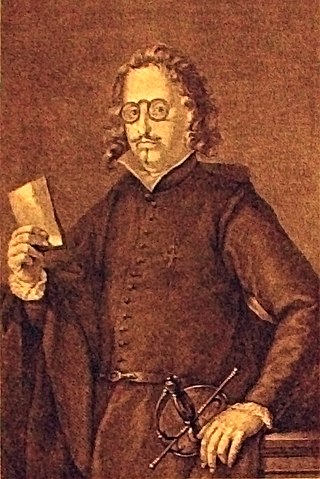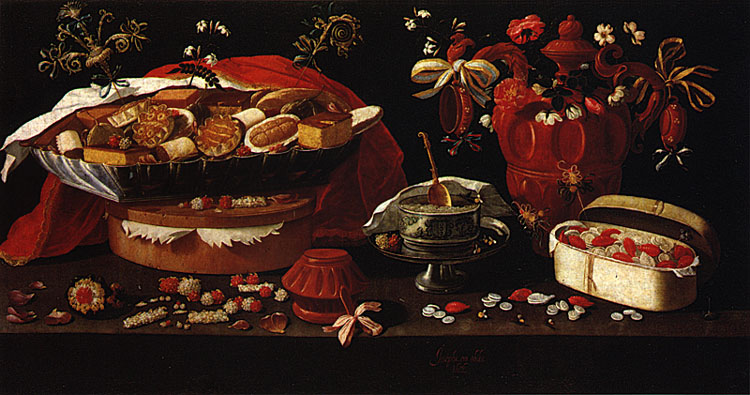Feel free to add any term you like to be authomaticaly linked throughout all the website.
Currently sorted By creation date ascending Sort chronologically: By last update | By creation date

Luis de G?ngora y Argote:Luis de G?ngora y Argote (11 July 1561 ? 24 May 1627) was a Spanish Baroque lyric poet. G?ngora and his lifelong rival, Francisco de Quevedo, are widely considered the most prominent Spanish poets of all time. | |
|
Francisco de Quevedo y Villegas:Francisco G?mez de Quevedo y Santib??ez Villegas (Spanish: [f?an?θisko ?e ke?βe?o]; 14 September 1580 ? 8 September 1645) was a Spanish nobleman, politician and writer of the Baroque era.  Along with his lifelong rival, Luis de G?ngora, Quevedo was one of the most prominent Spanish poets of the age. His style is characterized by what was called conceptismo. This style existed in stark contrast to G?ngora's culteranismo. (source: Wikipedia) | |
|
Baroque:The Baroque is a period of artistic style that used exaggerated motion and clear, easily interpreted detail to produce drama, tension, exuberance, and grandeur in sculpture, painting, architecture, literature, dance and music. The style began around 1600 in Rome, Italy and spread to most of Europe.  Still-life, by Portuguese painter Josefa de ?bidos, c.1679, Santar?m, Portugal, Municipal Library (source: Wikipedia) | |
|
Giuseppe Garibaldi:Giuseppe Garibaldi (Italian pronunciation: [d?u?z?ppe ?ari?baldi]) (July 4, 1807 ? June 2, 1882) was an Italian general and politician. He is considered, with Camillo Cavour, Victor Emmanuel II and Giuseppe Mazzini, as one of Italy's "fathers of the fatherland". Garibaldi was a central figure in the Italian Risorgimento, since he personally commanded and fought in many military campaigns that led eventually to the formation of a unified Italy. He generally tried to act on behalf of a legitimate power, which does not make him exactly a revolutionary: for example, he was appointed general by the provisional government of Milan in 1848, General of the Roman Republic in 1849 by the Minister of War, and led the Expedition of the Thousand on behalf and with the consent of Victor Emmanuel II.  He has been called the "Hero of Two Worlds" because of his military enterprises in South America and Europe. These earned him a considerable reputation in Italy and abroad, aided by exceptional international media coverage at the time. Many of the greatest intellectuals of his time, such as Victor Hugo, Alexandre Dumas, and George Sand showered him with admiration. The United Kingdom and the United States helped him a great deal, offering him financial and military support in difficult circumstances. In the popular telling of his story, he is associated with the red shirts worn by his volunteers in lieu of a uniform. (source: Wikipedia) | |
|
Austrian Empire:The Austrian Empire (Austrian German: Kaiserthum Oesterreich, modern spelling Kaisertum ?sterreich) was a modern era successor empire centered on what is today's Austria and which officially lasted from 1804 to 1867. It was followed by the Empire of Austria-Hungary, whose proclamation was a diplomatic move that elevated Hungary's status within the Austrian Empire as a result of the Austro-Hungarian Compromise of 1867. The Austro-Hungarian Empire (1867 to 1918) was itself dissolved by the victors at the end of World War I and broken into separate new states.  The term "Austrian Empire" is also used for the Habsburg possessions before 1804, which had no official collective name, although Austria is more frequent. (source: Wikipedia) |
Kingdom of Sardinia:The Kingdom of Sardinia (Italian: Regno di Sardegna, Sardinian: Rennu de Sardigna, Piemontese: Regn ?d Sard?gna; also known as Piedmont-Sardinia or Sardinia-Piedmont) consisted of the possessions of the House of Savoy from 1720 or 1723 onwards, following the award of the crown of Sardinia to King Victor Amadeus II of Savoy under the Treaty of The Hague (1720). This compensated him for the loss of the crown of Sicily to Austria and allowed him to retain the title of king, as the title "King of Sardinia" had existed since the 14th century.  Besides Sardinia, the Savoyard state at that time included Savoy, Piedmont, and Nice; Liguria, including Genoa, was added by the Congress of Vienna in 1815. During most of the 18th and 19th centuries, the political and economic capital of the kingdom was Turin in Piedmont on the Italian mainland. In 1860, Nice and Savoy were ceded to France in return for French consent and assistance in Italian unification. In 1861, the Kingdom of Sardinia became the founding state of the new Kingdom of Italy, annexing all other Italian states. The Kingdom thus continued in legal continuity with the new Italian state, to which it transferred all its institutions. (source: Wikipedia) | |
|
Piedmont:Piedmont (Italian: Piemonte, pronounced [pje?monte]; Piedmontese and Occitan: Piemont; French: Pi?mont) is one of the 20 regions of Italy. It has an area of 25,402 square kilometres and a population of about 4.4 million. The capital of Piedmont is Turin.  The main local language is Piedmontese. Occitan is also spoken by a minority in the Occitan Valleys situated in the Provinces of Cuneo and Turin. Franco-Proven?al is also spoken by another minority in the alpine heights of the Province of Turin. The name Piedmont comes from medieval Latin Pedemontium or Pedemontis, i.e., ad pedem montium, meaning ?at the foot of the mountains? (attested in documents of the end of the 13th century). (source: Wikipedia) | |
|
Expedition of the Thousand:The Expedition of the Thousand (Italian Spedizione dei Mille) was an event of the Italian Risorgimento took place in 1860. A corps of volunteers led by Giuseppe Garibaldi landed in Sicily in order to conquer the Kingdom of the Two Sicilies, ruled by the Bourbons.  The beginning of the expedition at Quarto. The project was an ambitious and risky venture to conquer, with a thousand men, a kingdom with a larger regular army and a more powerful navy. The expedition was a success and concluded with a plebiscite that brought Naples and Sicily into the Kingdom of Sardinia, the last territorial conquest before the creation of the Kingdom of Italy on March 17, 1861. The sea venture was the only desired action that was jointly decided by the "four fathers of the nation" Italian Giuseppe Mazzini, Giuseppe Garibaldi, Victor Emmanuel II and Camillo Cavour, pursuing divergent goals. It is difficult to determine the true instigator: Mazzini desired to release the Mezzogiorno and Rome while Garibaldi wants to conquer in the name of Victor Emmanuel II, the Kingdom of the Two Sicilies and continue to Rome to complete the unity of Italy, Cavour that wants to prevent at all costs to avoid a conflict with his French ally, Napoleon III, which protects Rome. The expedition also brings new large collective ambiguity and misunderstanding: for Garibaldi, it is to achieve a united Italy; to the Sicilian bourgeoisie, an independent Sicily as part of the kingdom of Italy, and for the mass farmers, the end of oppression and land distribution. (source: Wikipedia) | |
|
Bronte:Bronte is a town and comune of Sicily (in the province of Catania, Italy), near Mount Etna. Bronte, Sicily (See a bigger map) In 1860, during Garibaldi's Expedition of the thousand, there was a riot. The peasants had hoped for ? and did not get from Garibaldi ? an immediate relief from the grievous conditions to which they were forced by the landowners. They revolted in several localities, and at Bronte, on August 4, 1860, Garibaldi's friend Nino Bixio bloodily repressed one of these revolts with two battalions of Redshirts. (source: Wikipedia) |
Redshirts:Redshirts (Italian Camicie rosse) or Red coats (Italian Giubbe Rosse) is the name given to the volunteers who followed Giuseppe Garibaldi in southern Italy during his Mille expedition to southern Italy, but sometimes extended to other campaigns of his. The name derived from the colour of their shirts (complete uniforms were beyond the finances of the Italian patriots). | |
|


